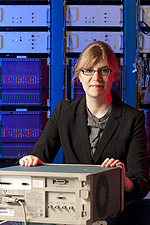Sam Zeller receives DOE award to track neutrinos in liquid argon
 |
|
Geralyn "Sam" Zeller won a DOE Early Career Research Award to support her work on liquid argon neutrino dectectors. Photo: Reidar Hahn |
Neutrinos are known for escaping capture. They fly through matter and their different types continuously morph into one another. That elusive, shifting behavior challenges nearly every available tool and capability scientists have to sketch their portraits.
With better tools come more detailed portraits. Last month, Fermilab scientist Geralyn “Sam” Zeller received a 2012 DOE Early Career Research Award to advance a detector technology that will capture neutrinos’ attributes with unprecedented detail. The $2.5 million award, spread over five years, will support a proof-of-principle study towards the construction of multi-kiloton liquid-argon neutrino detectors.
“There are some really important questions we want to answer about how neutrinos behave,” Zeller said. “The best chance for answering them is to study neutrinos with this exquisite detector."
Liquid-argon detectors are practically photographic in their ability to show what happens when a neutrino hits an argon nucleus. Tracks that the resultant particles leave behind are shown in high resolution, and it’s easy to distinguish the various particle types that arise from the interaction.
But information on how neutrinos behave in liquid-argon detectors is sparse. Most of what is known is based on simulations rather than experiment. Also, researchers have typically gathered what they need to know from event displays – pretty pictures of events that, while useful, are relatively light on quantified information.
Zeller, who has been at Fermilab since December 2009, plans to fill the gap with an abundance of new data. The DOE award will support the analysis of neutrino data recently collected by a small (less than 1 ton) liquid-argon detector prototype called ArgoNeuT. In the next few years, Zeller’s team will also generate and analyze neutrino data using Fermilab’s new MicroBooNE detector, a 170-ton liquid-argon detector. Their findings will tell them whether they can get the expected performance out of a detector of much larger scale. They’ll also characterize exactly how neutrinos behave when interacting in argon.
“There’s a big gap in our knowledge of how neutrinos interact,” Zeller said. “We want better information to inform the design of future detectors.”
Zeller’s project leverages the current ongoing U.S. neutrino program with the idea that the community could build, in manageable stages, a liquid-argon detector weighing tens of thousands of tons. Its prodigious size increases scientists’ chance of capturing a neutrino that has changed forms. Combined with its characteristic high precision, the detector would prove invaluable for the proposed Long-Baseline Neutrino Experiment, which will allow scientists to observe neutrino oscillations, as their form-changing is called. It would also be of use for the short-baseline program in looking for a fourth neutrino to add to the family of the known three.
If future neutrino experiments go well, scientists may finally have answers to basic questions surrounding the ghostly particle: which neutrino types are the lightest and heaviest, and do they behave the same as their antiparticles?
The DOE award will fund two postdocs and a dedicated team for the long-baseline program, as well as supporting technical and engineering work.
“There’s an opportunity here because we have these two detectors and the best neutrino beams in the world,” Zeller said. “Now we’re going to try to get as much information out of them as we can.”
—Leah Hesla
|